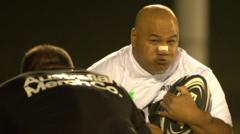The Run It Championship League, an adrenaline-fueled collision game originating from Australia and New Zealand, is expanding globally amid rising popularity. While touting the sport as a new spectacle attracting major sponsorship deals and a significant prize money, experts are increasingly vocal about the serious health risks associated with its violent nature, prompting debates on sports safety.
Global Ambitions Collide with Safety Concerns in New "Collision Sport"

Global Ambitions Collide with Safety Concerns in New "Collision Sport"
The Run It Championship League is rapidly gaining international attention, but concerns over safety and the commercialization of concussion are growing louder.
The Run It Championship League is taking the adrenaline-pumping essence of its backyard origins to international platforms, blending exhilarating competition with rising tension over safety concerns. The fiercely competitive one-on-one tackle game - touted as the "world’s fiercest, new collision sport" - has its roots deeply embedded in Australian and New Zealand Pacific Islander communities, where it first emerged on playgrounds and backyards.
In the league, competitors are matched in head-on collisions, charging towards one another without protective gear, resulting in formidable clashes that steel fans with both excitement and trepidation. Last Saturday, a bustling arena in Dubai witnessed the championships, with the winning contestant set to claim A$200,000 (£98,000). The league's founders, Brandon Taua'a and Stephen Hancock, exuberantly shared their personal experiences of the game’s local origins, reinforcing its authenticity and narrative appeal.
Despite its rising acclaim and viral social media presence, led by impressive sponsorship and extensive media coverage, the sport has ignited significant health-related debates. Medical professionals caution against the physical and mental toll of such violent games, particularly in light of tragic consequences, including fatalities attributed to similar activities. The case of Ryan Satterthwaite, a 19-year-old who suffered catastrophic brain injury during an amateur version of the sport, sharply highlights the potential dangers of encouraged contact activities among youth.
Competitors like champ Betham express excitement about monetary rewards that can alleviate financial woes despite the risks involved. In response to safety concerns, tournament organizers advocate for medical assessments and protocols intended to mitigate risks; however, experts remain skeptical, emphasizing that protocols cannot predict brain injuries arising from such intense collisions.
Additionally, mental health advocates condemn the game’s perceived reinforcement of toxic masculinity values, warning that glorifying pain tolerance in young men could be detrimental to societal norms. Experts stress the need for safer practices within contact sports, as governing bodies in traditional sports like rugby have hurriedly issued guidelines against participation in Run It-style games.
As the league sets its sights on expanding into markets like the UK and the US, its promoters argue the sport will carve a rightful place alongside established contact sports like MMA and boxing, dismissing safety critics as wary traditionalists. Their ambitious vision ensues amid cries for responsibility to safeguard participant health, whilst wary sports experts warn about the potential normalization of dangerous activities packaged as entertainment.























